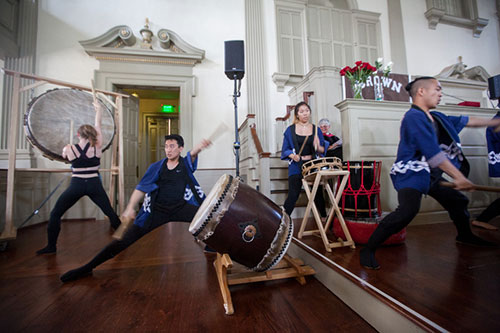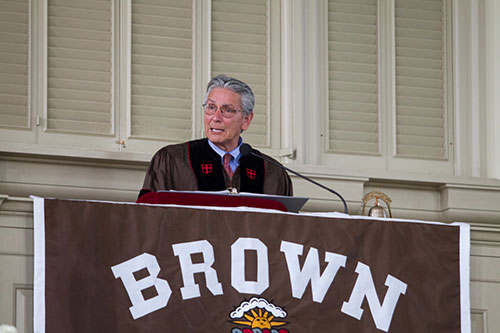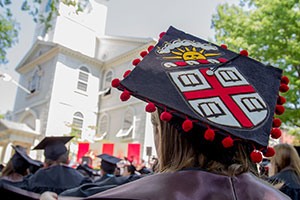PROVIDENCE, R.I. [Brown University] — The sounds of Malian drumming, ringing church bells and strains of Aaron Copland’s “Fanfare for the Common Man” mingled in the College Hill breeze this afternoon, greeting Brown’s Class of 2016 as the candidates entered the Meeting House of the First Baptist Church in America for the University’s annual Baccalaureate service.
Brown’s Baccalaureate tradition, like those at other universities, originates in the medieval European custom of presenting the candidates with “the laurels of sermonic oration.” For this reason, the ceremony always includes an oration given by a notable speaker — this year, honorary degree recipient Kevin Gover, director of the Smithsonian Institution’s National Museum of the American Indian.
Yet in a one-of-a-kind Brunonian take on this time-honored tradition, Brown’s event weaves in prayers, texts, dances and songs that represent the many spiritual traditions within the University community. Above all, said the Reverend Janet M. Cooper Nelson — the Brown chaplain, who each year oversees the creation of the service — the Baccalaureate is a celebratory moment of faith, gratitude and thanksgiving.

“The service embraces the many modes of beauty and expression, drawn from the spiritual traditions, identities and practices of the Brown community, by which we express gratitude — without privileging one over another,” Nelson said. “It is intentional in celebrating the breadth of Brown’s diversity. But inside First Baptist, for 90 minutes, we are, briefly, a joined community within the walls of an extraordinary place at the heart of Brown’s long history.”
That history is reflected within the Meeting House — erected in 1775, 11 years after Brown was founded — on a plaque that states that the building is “for the Publick Worship of Almighty God and also for holding the Commencement in.” Central parts of the the University’s Commencement ceremonies have been held there since.
This year’s Baccalaureate was at once reflective and reverential, somber and celebratory, featuring a wide range of spiritual, secular and artistic traditions. Included in the ceremony were prayers of worship and thanks from Wampanoag, Buddhist, Sikh, African ancestral, Muslim, Jewish and Christian traditions, as well as gospel music, South Asian dancing, Taiko and Malian drumming, and a Chinese lion dance. The texts were recited, chanted or sung by students in the Class of 2016 who were active in religious life on campus during their four years at the University.

“It was really wonderful to see so many religions represented, not just one,” said graduate Lillian Dominguez after the service. “The text and songs and dances were very moving and beautiful.”
The service also incorporated remembrance of Brown students from the Class of 2016 who have died, as well as Brown faculty, faculty emeriti and staff who passed away during the past year.
Afterward, University President Christina Paxson introduced Gover, who delivered an address titled “Choosing Our Histories,” in which he charged the Class of 2016 to not only make history, but to do the important work of remaking it. Gover, a citizen of the Pawnee Nation of Oklahoma, spoke of the many historical figures that were celebrated in his youth but whose legacies are now being re-interrogated — cultural heroes like General George Custer and Christopher Columbus, whose abuses against American Indians are now decried.
“I never learned anything in my public school education that made me proud of my Native American ancestors,” he said. “The racial messages I took from my schooling were so powerful that I wondered whether the reason I was smart was that my mother was white. Fortunately, I had parents who helped me understand, and I got the opportunity to study at one of the world’s great universities, and realized that these American origin stories had arisen from some very old and very wrong ideas about culture, religion and race.”
WATCH VIDEO: 2016 Brown University Baccalaureate Ceremony
He said that transforming our country’s origin stories into ones that are “introspective, inclusive and rigorously honest” is important work — but he cautioned graduates that in remaking history, they should not “settle for simple constructs.”
“We should not seek to erase those of whom we disapprove,” Gover said. “We can find something to dislike in all of our noteworthy historical figures, but we should not let our dislikes blind us to their merits. We must be humble in our opinions and judgments about history, about politics and policy, even about art and science. Here’s why: You may know a lot, but what you know is dwarfed by what you do not know.”
His message resonated, graduates said.
“I was very moved when he talked about what it means to recreate history,” Kerlyne Jean-Baptiste said of Gover’s address. “His words were very connected to how we, as change-makers, have been recreating history here at Brown.”
Gover ended his address with a single charge — “Go and change the world!” — that magnified the Wampanoag prayer recited earlier: “As we go forward from this place… help us to do only what is right.” The occupants of the Meeting House left him with a resounding standing ovation.
